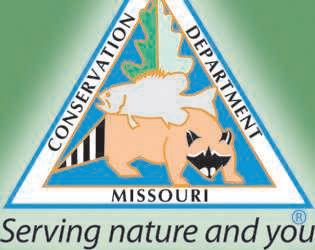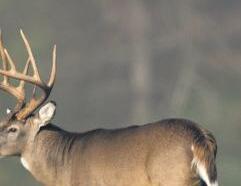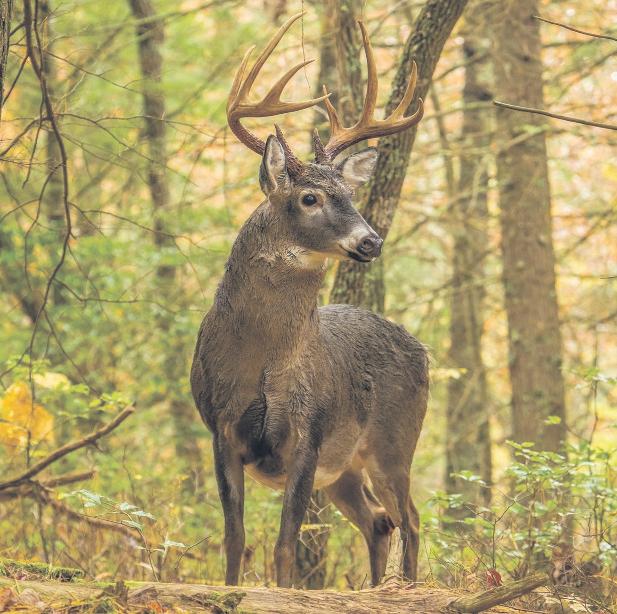










From the front: Gavin Twomey, left, poses with his first kill. At top right, Laney Walker, 13, enjoys hunting with her dad. At bottom, right, Jaxon, Jeremiah, Wilson and Weston Dietiker use the same pose whenever one of them gets a deer.
















From the front: Gavin Twomey, left, poses with his first kill. At top right, Laney Walker, 13, enjoys hunting with her dad. At bottom, right, Jaxon, Jeremiah, Wilson and Weston Dietiker use the same pose whenever one of them gets a deer.




Every fall, Missouri hunters prepare to hunt the ever-elusive whitetail deer.
Young and old, we all dream of harvesting a giant buck in a soft green meadow with a beautiful sunrise or sunset in the background.
For hundreds of years, men and women alike have been hunting these animals for food to feed their families. Hunting may sound like a cruel practice to some, but it is a must to control the population.
I usually shoot my bow 12 months out of the year. I not only hunt for food, but I enjoy shooting my recurve just for fun. I might just pick it up to target shoot in the backyard or try to get a squirrel or some other small game that wanders into my backyard that might be in season. It sounds a little crazy, but if I take some sort of game, I eat it. Small game tastes just as good as big game as long as it’s prepared correctly, and for me, it’s a huge challenge to hit a moving squirrel or rabbit compared to a 150-pound deer. Shooting those small targets hone my skills to make my shot count when that huge deer is standing in
front of me.
The night before the opening day of deer season is almost like Christmas Eve, waiting in anticipation for the exciting morning to come. You really don’t know what to expect the next morning, you just know that you are super-excited and can’t sleep. You pack your backpack with whatever you think you need in the woods. Besides drinking water, you don’t want to forget doe urine. You can’t go into the woods without soaking your boots in it, hoping that a huge buck will follow your trail straight to where you are hunting.
In the 30 years I’ve been hunting, I don’t think a deer has ever followed a trail I’ve left, but it’s something my dad taught me, and I have passed it on to my children.

You also have to pack snacks. Our snacking tradition has always been peanut butter crackers and cans of Beanie Weenies. I am completely convinced that the smell of peanut butter is something that draws every squirrel within a mile of where you are hunting straight to you. It’s amazing how a little three-pound squirrel can sound like a 200-pound deer walking through the woods.
Now comes the time for getting up in the morning. Of course, you are completely exhausted because you didn’t get near enough sleep. You slide into your camo that you haven’t worn in at least eight months, and it still smells like the doe urine you sprayed on your boots the year before. It almost makes you sick to your stomach, but then it hits
you — you’re headed to the woods to take part in one of the most amazing activities you’ll do all year.
Typically, on the way to your hunting spot, you will see a deer around every corner on the road. It makes your excitement grow and grow. Finally, you arrive. In my case, I park at the end of the cornfield, climb out of the truck and start grabbing all my gear.
Guaranteed, I will have forgotten something. All the years I’ve been hunting, I have still forgotten a wide variety of things like the release for my compound bow. One year I even forgot the bullets for my rifle. Good thing I happened to have one round in my orange vest from the year before! The old trusty Marlin 30-30 just needed that one round to get a doe that
day. I make the walk around the woodline up to my trusty spot and get comfortable.
Words can’t explain the peace you feel sitting in the silence of the woods right before daylight. As the sun starts to rise, then the woods seem to start coming alive. In my spot the past few years, I typically see fawns playing in the field almost every opening morning. There is something majestic and beautiful about baby deer playing and enjoying just being alive. You can sit there and hear the sounds of the birds and the wind just drifting around. If you close your eyes and smell the different scents of flowers — even the dirt that’s around you — it almost brings you to a point of pure relaxation.
It sounds funny, but you haven’t even seen a shootable animal yet, and you have
gotten more out of the day in an hour than you usually get in all 24.
Once a deer walks out within shooting range, you feel all these emotions. Your heart starts to race, and sometimes your hands start to tremble. You must make sure to settle your nerves to get the perfect shot placement. You want to harvest the animal as quickly and cleanly as possible. Once you have made your shot, you have hopefully dispatched the animal quickly. Then the real work happens. Now that you have made your harvest, you must tag it immediately and telecheck it with MDC.
Finally, you must then prep your harvest for the table. This may sound like a cruel process to some and there are a lot of people out there that disagree with it. But without hunting animals, their numbers would get out of control.
It is a powerful thing to take an animal from the wild and place it on your table to feed your family. It is the circle of life. Humans and animals alike have been eating other animals since the beginning of time and will continue to do so.
I wish all hunters the best of luck this fall and winter.
“It’s amazing how a little threepound squirrel can sound like a 200-pound deer walking through the woods.”
before opening day is
 Teresa Ressel Inserra
Teresa Ressel Inserra
Gavin Twomey was a Deer Season baby so it’s only natural that he would love hunting.

For the past three or four years, he’s gone hunting with his dad, James.
“We always do it on my birthday,” 10-year-old Gavin, a fifth grader at Central West Elementary, said proudly. “My birthday is Nov. 20. I get to miss school that day. I go hunting instead of school.”
He doesn’t so much mind getting up early and being in the cold. He enjoys hearing the deer, seeing it, and then killing the deer and “eating deer meat.”
“This year I get to clean my own,” he said. “I’m kinda excited.”
This year, he will be able to hunt on his own property. Besides hunting deer, they also hunt turkey and “we fish a lot.”
Brothers Jaxon, 13, and Wilson Dietiker, 10, of Fredericktown, each started hunting with their dad, Jeremiah, when they were 6 years old. The youngest brother, Weston, 4, is too young to hunt for now.



Hunting is Jeremiah’s favorite hobby so it has been exciting to hunt with his children on the same property he hunted on when he was a kid.
Every year, the brothers said that they stay the night at the family cabin, “eat junk food,” play games and hang out with family from out of town. The property was
Jeremiah’s home when he was young – now it’s home to the family’s hunting cabin.
They have a game camera where they can spot the deer daily. The kids name them.
“We try to go after certain ones,” Jeremiah said.
Jeremiah said anytime he gets a big deer, the family takes a picture using the same pose. “We have multiple deer with the exact same pose,” he said.
Jaxon and Wilson agree that their favorite thing to hunt is white-tailed deer with a gun.
Jaxon said they hunt with their dad and grandpa when their grandpa is in town.
Jaxon’s favorite memory was when he was 7 and it was youth gun season. A deer came out and he shot at it, hitting it in the leg. He shot it a second time and missed. His dad shot at it and missed. Finally, with a third shot, Jaxon hit it and the deer went down.

Wilson said he missed a couple before he got his first deer. He said during alternative season when he was 9, he shot at a deer with a .223 AR pistol and missed. But he saw it still standing there and was able to shoot it in the back. He said he was nervous and excited.
This deer season will be 7-year-old Kemper Parson’s second year hunting but he’s already made several memories with his parents, Randall and Heather.

“I shot a hog on the first day of deer season,” he said, adding it was about a hundred yards away.
He and his dad looked for it and found the feral hog still alive so he shot at him two more times. He admitted it was a little scary.
He also got a buck with a blackpowder gun on Christmas Day and a doe with a rifle on Halloween. In addition to deer, he’s killed a turkey and two squirrels.
Cameron Burnham, a North County junior, has been hunting with his Papa



he was to the camera deer them. certain he takes pose. with the agree that hunt is gun. with when memory it was deer it, shot it missed. His missed. FiJaxon down. missed a first alterna9, .223 But there in the nervous be Parson’s he’s memoRandall first said, hundred looked for hog still two admitted it with a Christa rifle addition to and has Papa
Dennis Linderer for 12 years and they’ve made a lot of memories together.
Cameron hunts duck, turkey, rabbit, dove, and squirrel but his favorite is deer hunting with a bow.
“Bow season starts Thursday,” Cameron said Sept. 13. “I can’t wait.”
One of his favorite memories was his first year. He was sleeping on his papa’s lap when his papa woke him up for a deer.
“I couldn’t hold a gun yet so he held it for me and shot my first deer,” he said.
He remembers his first year hunting by himself – he was 8 and a doe came about five yards from the stand. By the time he was 13, he was already cleaning his own deer.
“After a kill, me and my papa give each other big hugs,” he said.
Laney Walker, 13, of Fredericktown, has been hunting with her dad, John since she was 7 or 8. They hunt deer on a family friend’s property. She’s killed five deer so far, the biggest being the eight-pointer she killed last year.



Her favorite memory is killing her first deer when she was 9.
“I shot it and my dad yelled ‘Woohoo’ really loud,” she said. “He hugged me and said, ‘Great job!’ Mom was really proud of me and happy. The whole family called me ‘the deer slayer.’”
Laney enjoys spending the time with her dad … and also killing deer. She said it is one of her hobbies and a family tradition.
“Almost everyone in the family hunts except the younger ones and my sister,” she said.
Laney’s mom still hunts with her own dad. “It’s kinda like dad and girl bonding time,” April said.
Laney said she watches her dad and grandpa clean and gut the deer so she will know how to do it when she is older.
Laney’s cousin Sydney Dunnahoo, 14, of Fredericktown, has been hunting about seven years. Her favorite thing to hunt is deer.
Her favorite memory is, “Getting my first deer, exploding the heart and trekking her up a mountain side.”
Mason Golden, 10, has been hunting for about four years. His favorite animals to hunt are coons and deer but he also hunts turkey, squirrel and rabbits.

Mason, who attends Central West Elementary, said his favorite hunting memory is killing his first deer because it was with his dad, Clayton, and it was with a crossbow at his Grandpa Golden’s house.


His mom, Melissa said every fall he goes with his grandpa, dad and uncles to deer camp.
Kellen Crepps, 10, a North County Intermediate School student, has been hunting with his dad since he was 4.
He enjoys rifle hunting for deer with his dad and his brothers at his house. He also hunts for rabbits and fishes on their 30-acre property.
His brother Maddan Crepps, 8, likes to go with their dad while he’s hunting. He said his favorite memory so far was last year when he was with his dad and his dad killed a small deer. He’s looking forward to his dad getting a buck this year.

Missouri Department of Conservation K9 Handler Cpl. Alan Lamb and K9 Tex have become an important part of the community.
Tex is a 3-year-old male German Shorthair Pointer with extensive training. He attended the Indiana Department of Natural Resources Wildlife Law Enforcement K9 Tracking and Detection School.

According to Lamb, Tex is trained in three disciplines: human tracking, article search/evidence recovery, and wildlife detection.
“He can also assist in search and recovery efforts of missing persons,” Lamb said. “His ability to follow a human track or scent trail helps to locate these missing people and hopefully bring them home safe.”
Other than locating missing persons such as hunters, hikers, dementia patients and fleeing fugitives, Tex can also locate discarded or hidden items that contain human odor, such as firearms or even shell casings.
The ability to locate concealed or hidden game such as deer, turkey, and waterfowl makes Tex especially useful to the MDC.
“Many times when illegal hunters or poachers try to avoid being caught they hide evidence, stomp the ducks into the mud or maybe we need that missing shell case to close the case and file wildlife charges,” Lamb said. “In years past, these items were extremely difficult to locate. Not anymore.
“Tex has assisted in the recovery of numerous items that have led to multiple wildlife
charges being filed.”
Lamb said the first poaching case the duo made involved a couple waterfowl hunters who harvested several ducks during closed season.
“Another agent watched the hunters stomp the ducks into the deep mud of a wetland pool,” Lamb said. “After contacting the hunters and failing to retrieve the ducks, he requested the help of Tex. Once on scene, the search lasted a matter of minutes before Tex had located the stomped ducks. Had Tex not found the ducks, there would be no evidence in the case.”
Having Tex and Agent Lamb living and working in Madison County is a tremendous asset to the community.
“His ability to locate evidence and assist in the prosecution of criminal activity is of great benefit to any agency that needs us,” Lamb said. “Also, his ability to assist with search and rescue efforts of missing persons is a huge benefit to the community.”
Lamb said there are always stories to tell and he already has several when it comes to Tex’s skills.
“Tex and I were requested by Sikeston DPS over the summer to assist in locating a discarded firearm used in a criminal case,” Lamb said. “Detectives had searched a heavily brushed area for several hours before giving up and making the request call.
“Tex and I arrived the following day. We worked the area for almost two hours before Tex showed a change of behavior.”
Lamb said this change of behavior is what Tex does when he locates an evidence item.
“When I noticed this change, I started to wonder what he was doing, however,
when he locked eyes with me, I knew that he located some thing,” Lamb said. “When I arrived at his location, I discovered he had located the discarded firearm. This was a tremendous victory not only for us as a K9 team but also for the citizens of Sikeston and the Sikeston DPS.”
Lamb and Tex do not take their job lightly. They take every opportunity they can to train, although it seems to feel more like fun than work for Tex.
“You have to remember, training is a word that we use,” Lamb said. “It has no meaning to ‘Tex’ Training to him is like recess for the kids. He loves to work.”
Lamb said the two are always looking to acquire new skills and strive to make train ing new and challenging.
“It’s like raising a teenager,” Lamb said. “There are so many times that he makes me so proud. Then there are other times I cannot figure out what he is thinking.
“Either way, I am extremely proud of where we are at in our careers and the job that he does. He is my buddy that loves nothing more than going to work. We are partners through thick and thin. If I am at work, he will be with me.”
Tex and Lamb may be inseparable now but not long ago it was not even part of the plan.
“I’ve always had personal dogs but to work with one as a K9 handler was something new,” Lamb said. “When the opportunity to apply for the position came open, the timing was right. I was in the right position in my personal


life and career for it to really work. Now I cannot imagine doing anything else. It is the best career move that I have ever made.”
There are 37 states and the US Fish and Wildlife Service, and Customs and Border Protection that operate Wildlife Law Enforcement K9s. In Missouri, there are currently five K9 teams located throughout the state. These teams are specifically trained in wildlife detection.
“Becoming a K9 officer is the best thing I have done in my 13 years as a conservation agent,” Lamb said. “I am very proud of the MDC and what they do for the state and our local communities. I am fortunate to be back in my hometown serving as a K9 Conserva tion Agent.”
Missouri Department of Conservation currently has five Wildlife Enforcement K9s. From left are Cpl. Alan Lamb and K9 Tex, Cpl. Justin Pyburn and K9 Korra, Cpl. Susan Swem and K9 Astro, Cpl. Don Clever and K9 Penny, and Cpl. Caleb Pryor and K9 Waylon.

PROVIDED BY MDC
Cpl.
The Missouri Department of Conservation (MDC) wants deer hunters to know some key information for harvesting whitetails in Missouri this season.
Deer hunting opens Sept. 15 with the archery season, which runs through Nov. 11 and then again from Nov. 23 through Jan. 15. The two firearms youth portions occur on Oct. 29 and 30 and Nov. 25-27. The firearms November portion runs Nov. 12-22. The antlerless portion runs Dec. 3-11. The alternative-methods portion runs Dec. 24 through Jan. 3.
Hunters who are 15 years or younger on Sept. 15 are now exempt from the antler-point restriction during the archery season and all portions of the firearms deer season. The antler-point restriction has been removed for Barton and Vernon counties. Hunters may now fill additional firearms antlerless permits in a number of counties. Get details at MDC’s website.
MDC encourages deer hunters to share their harvests by donating surplus venison to the Share the Harvest program to help feed hungry Missourians. The program is administered by the Conservation Federation of Missouri and MDC and has provided nearly 5 million pounds of lean, healthy venison to help feed hungry Missourians since it was start ed in 1992.
Donating is easy. Simply
take harvested deer to an approved meat processor and let the processor know how much venison to donate. Meat-processing fees are covered entirely or in part by numerous local sponsors, along with statewide sponsors. The donated deer meat goes to local food banks and food pantries to help feed hungry Missourians all around the state. To get Share the Harvest venison, contact local food banks or food pantries.
The National Institutes of Health state that children need protein in their diets for proper growth and development, and adults need it to maintain good health. Yet many Missourians can’t afford or can’t get to good sources of protein. Through Share the Harvest, Missouri hunters can help provide those in need with high-quality protein in the form of naturally lean, locally harvested deer meat.
Chronic wasting dis ease (CWD) is a deadly, infectious disease in deer and other members of the deer family (cervids) that eventually kills all animals it infects. There is no vaccine or cure. CWD is in Missouri and MDC continues its efforts to limit the spread of CWD by finding new cases as early as possible and managing the disease to slow its spread to more deer in more areas.
MDC’s CWD Manage ment Zone consists of counties where or near where CWD has been
found: Adair, Barry, Barton, Camden, Cedar, Chariton, Christian, Clark, Craw ford, Franklin, Gasconade, Greene, Hickory, Howell, Jefferson, Knox, Laclede, Linn, Macon, McDonald, Mercer, Oregon, Ozark, Per ry, Polk, Pulaski, Putnam, Ripley, St. Charles, St. Clair, St. Francois, Ste. Genevieve, Stone, Sullivan, Taney, Vernon, Warren, and Wash ington. MDC notes that Barton, Greene, Ripley, and Vernon counties are new to the CWD Management Zone this year.
Special regulations apply in CWD Management Zone counties, including:
During Nov. 12–13, hunters who harvest deer in CWD Management Zone counties (except Gasconade, Knox, St. Charles, and Warren) must take the deer or deer head on the day of harvest to an MDC mandatory CWD sampling station.
The use of grain, salt products, minerals, and other consumable products used to attract deer is prohibited year-round in CWD Management Zone counties.
Deer harvested from CWD Management Zone counties must be reported through Telecheck before they can be removed from the county of harvest.
Hunters must follow carcass-movement restrictions for deer harvested in a CWD Management Zone county.
Hunters must also follow carcass-movement restrictions when bringing parts of harvested deer and other cervids into Missouri from another state.
As part of its efforts to find cases of CWD early and help slow its spread, MDC is again offering free voluntary CWD sampling and testing of harvested deer during the entire deer season at select locations throughout the state, including some MDC offices and participating taxidermists and meat processors.
MDC also offers self-service freezer drop-off locations within the CWD Management Zone for hunters to deposit harvested deer heads to have tested for CWD. Instructions, packing supplies, and information tags are available at the sites. Get more information on voluntary sampling and dropoff locations online at mdc. mo.gov/cwd.
Hunters can get their CWD test results for free online at mdc.mo.gov/cwdResults. Results are usually available within four weeks or less from the time of sampling.
MDC reminds hunters that bicycles and certain types of electric bicycles are now allowed on service roads and multi-use trails at about 300 conservation areas, including some also open for deer hunting.
Approximately 30 of these areas will be closed to bicycle and electric bicycle use during all por tions of the firearms deer hunting season. Bicycle use on most of MDC’s approximately 1,100 conservation areas is still restricted to roads open to
public-vehicle traffic and some multi-use trails. Cy clists may not ride off-road or off-trail.
Get more information on deer hunting in Missouri — including seasons, CWD restrictions and other regulations, permits, methods, where to hunt, and more — from the MDC website at mdc.mo.gov/ hunting-trapping/species/ deer and from MDC’s 2022
Fall Deer & Turkey Hunting
Regulations and Information booklet, available where permits are sold and on the MDC website.
Buy Missouri hunting and fishing permits from numerous vendors around the state, online at mdc.mo.gov/ permits, or through MDC’s free mobile app, MO Hunting, available for download through Google Play or the App Store.
MDC offices will be closed for permit sales and other activities on Veterans Day, Nov. 11.
Monitoring possible disease outbreaks is critical to protecting the health of wildlife in Missouri. Please report observations of the following:
• Single deer that appear sick, especially deer that are skinny and acting oddly
• Three or more sick or dead mammals
• Five or more sick or dead birds
• Groups of sick and dead amphibians or reptiles
Report any observations of sick or dead wildlife that meet these criteria to WildlifeHealth@ mdc.mo.gov
Avoid handling sick or dead wildlife.
If you must handle a dead animal, always wear gloves and wash your hands after.
Any mammal can carry rabies — be cautious of any mammal that is acting strangely.
Never corner a bear — make sure it has an escape route.
Back away slowly with your arms raised.
Speak in a calm, loud voice.
Do not turn your back to the bear. Walk away slowly — Do not run.
Archery: Firearms/November Firearms Firearms Firearms Turkey
Fall Archery: Fall Firearms: Spring Spring: Waterfowl Teal: Sept. Ducks, Youth Middle Youth South Ducks Middle North Zone: South Ducks, Greater Brant Geese: Light Geese: Canada Light Goose Other Badger: Bear: Oct. Beaver
Bobcat: Coyote: Coyote Crow: Nov. Dove/Falconry: Dove Hunting: Elk: Oct. Elk Hunting/Firearms: Fox (red/gray) Frog (green Groundhog: Mink Trapping: Otter and
Opossum: Pheasant: Pheasant
Quail: Nov. Quail Youth:
Rabbit: Rabbit Raccoon
Archery: Sept. 15-Nov. 11; Nov. 23-Jan. 15
Firearms/November portion: Nov. 12-22
Firearms Alternative Methods: Dec. 24-Jan. 3
Firearms Antlerless Portion: Dec. 3-11
Firearms Youth: Oct. 29-30, Nov. 25-27
Fall Archery: Sept. 15-Nov. 11, Nov. 23-Jan. 15
Fall Firearms: Oct. 1-31
Spring Youth: April 9-10
Spring: April 18-May 8
Teal: Sept. 10-25
Youth Middle and North Zone: Oct. 22-23
Youth South Zone: Nov. 19-20
Middle Zone: Nov. 5-13, Nov. 19-Jan. 8
North Zone: Oct. 29-Dec. 27
South Zone: Nov. 24-27, Dec. 7-Jan. 31
Ducks, Coots, and Mergansers Falconry: Feb. 10-March 10
Greater White-Fronted Geese: Nov. 11-Feb. 6
Brant Geese: Oct. 1-9, Nov. 11-Feb. 6
Light Geese: Nov. 11-Feb. 6
Canada Geese: Oct. 1-9, Nov. 11-Feb. 6
Light Goose Conservation Order: Feb. 7-April 30
Badger: Nov. 15-Jan. 31
Bear: Oct. 17-26
Beaver and Nutria: Nov. 15-Feb. 28
Bobcat: Nov. 15-Jan. 31
Coyote: Jan. 1-Dec. 31
Coyote trapping: Nov. 15-Feb. 28
Crow: Nov. 1-March 3
Dove/Falconry: Sept. 1-Dec. 16
Dove Hunting: Sept. 1-Nov. 29
Elk: Oct. 15-23
Elk Hunting/Firearms: Dec. 10-18
Fox (red/gray) hunting/trapping: Nov. 15-Jan. 31
Frog (green or bull): June 30-Oct. 31
Groundhog: May 9-Dec. 15
Mink Trapping: Nov. 15-Feb. 28
Otter and Muskrat Trapping: Nov. 15-Feb. 28
Opossum: Nov. 15-Feb. 28, Aug. 1-Oct. 15
Pheasant: Nov. 1-Jan. 15
Pheasant Youth: Oct. 29-30
Quail: Nov. 15-Jan. 31
Quail Youth: Oct. 29-30
Rabbit: Oct. 1-Feb. 15
Rabbit trapping: Nov. 15-Jan. 31
Raccoon hunting/trapping: Aug. 1-Oct. 15, Nov. 15-Feb. 28
Sora and Virginia Rails: Sept. 1-Nov. 9
Squirrel: May 28-Feb. 15
Striped Skunk: Aug. 1-Oct. 15, Nov. 15-Feb. 28
Wilson’s Snipe: Sept. 1-Dec. 16
Woodcock: Oct. 15-Nov. 28
Bear Permit Application (May 1-31)
Elk Permit Application (May 1-31)
Upper Mississippi Blind Draw (June 18 - July3)
Elk/Bear Permit Draw Results (July 1)
In-Season Waterfowl Draw (Oct. 12 - Jan. 17)
In-Season Waterfowl Draw Results
Managed Deer Hunt Application (July 1-31)
Managed Deer Hunt Results (Aug. 15)
Pre-Season Waterfowl Draw (Sep. 1-18)
Pre-Season Waterfowl Draw Results (Oct. 1)
Spring Turkey Managed Hunts (Feb. 1-28)
Spring Turkey Managed Hunt Results (March 15)
Ingredients:
2 pounds venison strips, cut 1/4-1/8” thick
1/4 cup soy sauce
1/4 teaspoon black pepper
1/2 teaspoon onion powder
1/2 teaspoon salt
A few drops of liquid smoke
1 tablespoon Worcestershire sauce
1/4 teaspoon garlic
1 teaspoon hickory smoke salt
Dash of cayenne pepper
Instructions:
To cut thin, even slices, use meat that is partially frozen. Cut the strips lengthwise with the grain and about 1 to 2 inches wide. Mix the seasonings and place the meat and seasonings in a resealable plastic bag. Work the seasonings into the meat with your hands. Refrigerate for several hours or overnight.
Baby animals are rarely abandoned. The wildlife parent is afraid of people and will retreat when you approach. If the baby animal is left alone, the parent will usually return. In addition, parent animals cannot constantly attend their young. Often they spend many hours each day gathering food.
Wild animals, if they are to survive in captivity, often require highly specialized care. Without such care they will remain in poor health and may eventually die.
As wild animals mature, they can become dangerous to handle and damaging to property.
Animals are better off in their natural habitat where they are free to reproduce and carry on their species.
If a wild animal is broken to captivity, it will probably die if returned to the wild.
Many wild animals are nocturnal. This means that they are not active until after dark. They sleep during the day and can be quite disturbing at night while people sleep.
Native wildlife carry mites, ticks, lice, fleas, flukes, roundworms, tapeworms, rabies, distemper, tuberculosis, respiratory diseases, and skin diseases. Some of these diseases can be transmitted to humans.
It is illegal to possess many wild animals without a valid state or federal permit. See the Wildlife Code of Missouri for details, or contact the Missouri Department of Conservation, P.O. Box 180, Jefferson City, Missouri 65102.
To dry, place on dehydrator trays and follow the directions of the appliance. Jerky can also be dried in an oven by hanging the strips with toothpicks from the racks. Cook for 10-12 hours at 150F. with the door slightly ajar to allow moisture to escape. Place a tray under jerky to catch drips.
Diversify your venison cuisine with this savory stroganoff.
Ingredients:
1 pound venison sirloin steak
1 8-ounce carton sour cream
2 tablespoons flour
1/2 cup water
2 teaspoons beef bouillon
1/2 teaspoon salt
1/4 teaspoon pepper
2 tablespoons margarine or butter
1 1/2 cups sliced mushrooms
1/2 cup chopped onion
1 clove garlic
Hot cooked noodles
Instructions:
Partially freeze venison and slice across the grain into bitesize strips. Set aside. Stir together sour cream and flour. Stir in water, bouillon, salt and pepper. Set aside. In a large skillet, cook and stir the meat in hot butter until done. Remove from skillet. Add mushrooms, onion and garlic. Cook and stir until done. Mix meat and vegetables together. Stir flour mixture into skillet. Cook and stir until thick and bubbly. Serve over noodles. Serves 4.
Hunting is ranked as one of the safest sports.
How safe is it? In 2019, more than 15 million people paid for hunting licenses. The Hunter Incident Database that year reported only 56 hunting-related shooting accidents, eight caused by handguns, 23 by shotguns and 25 by rifles. Most of the incidents were nonfatal.
Of course, not all hunting accidents involve guns. Some involve bows, boats, injuries from wildlife or even vehicle-related accidents. The International Hunter Education Association reports that the U.S. and Canada combined see around 1,000 accidents on an annual basis with close to 10% of these ending in death.

One of the reasons it is so safe is that many states require hunting safety classes and the U.S. Department of Interior always recommends them. New York was the first state to require hunter education certification to legally hunt. It did this in 1949. Most other states followed suit.
According to Steve Hall, a hunter educator coordinator for the Texas Parks and Wildlife Department, data shows a definite correlation between hunter safety and the decline in firearms-related hunting accidents. He said the primary causes of hunting accidents are careless handling of firearms, swinging on game
and victims in the line of fire being mistaken for game.
The following guidelines are from state hunting sites and the U.S. Department of the Interior.
• Tell someone when and where you will be, how long you plan to be there and schedule check-in times.
• Hunt with a partner and know your zone of fire.
• Carry a two-way communications device that gets service in remote areas.
• Wear your life jacket when hunting in or near water.
• Wear proper hearing protection and safety glasses.
• Treat every gun as if it is loaded.
• Never point the muzzle of a firearm at anything you don’t intend to shoot.
• Keep your finger off the trigger and out of the trigger guard until your sights are on the target and you are ready to shoot.
• Know your target and what is beyond it.
• Unload the firearm when getting in or out of a tree stand.
• Make sure your barrel and ammunition are free from obstructions.
• Use the proper ammunition.
• Maintain three points of contact with your hands and feed when climbing up or down a tree.
• Use a full-body harness that is attached to a secure fall line positioned above your head.
• Use a secure pull system to lift your firearm or crossbow into a tree stand.
• Make sure your tree stand is securely attached and stable before you use it.
• Obey no trespassing signs.
• If your game goes into property marked “no trespassing,” get the landowner’s permission to retrieve your game.
• Wear as much hunter orange as possible to increase your visibility. Orange does not affect deer behavior.
• Wear hunter orange as the outermost layer of clothing that is visible from all directions. This can include a cap, hat, vest, jacket or rain coat.
• Orange garments must be at least 50% hunter orange to meet legal requirements.





How a person hunts is often steeped with traditions, ritual, folklore and superstition. Some are born of cultures, others are passed down through families.

Native Americans are not a single group with a single culture. Traditions vary by tribe and geography, but many of them have traditions around hunting.
For example, Jacob Broadley wrote about Cherokee Traditions at the site Classroom.com. Men purified themselves in a sacred ritual before the hunt. Cherokee would abstain from sex for four days before and four days after a hunt. Before the hunt, they’d dip in a pool of water at sundown while singing an ancient chant. The next day, the hunter would not eat at all and would again dip in the water while chanting at sundown. On the second night, he’d cook a meal, eat it and then spread the fire ashes across his chest. On the third morning, the hunt would begin.
Ojibway tribes believed that everything was created for a purpose and that the purpose of animals were to feed the Anishnaabe people. They were taught, according to the Tribal
Trade website, that they should be thankful for the gift. Any time a hunter killed an animal, he would pray and give thanks. They were also taught that if they stopped hunting and fishing, it meant they were being ungrateful for the gifts they had been given.
Modern hunters carry on a variety of traditions and customs, some widespread, some practiced by only a few. Some are very superstitious
about what they eat s, such as eating cranberry sauce on Thanksgiving Day; others require the consumption of buckwheat pancakes the morning of the hunt.
Other traditions include:
• Blooding: The faces of hunters are marked with blood from their first kill, usually applied by a parent or an elder member of the camp with their fingers. This ritual dates back to the eighth century, when it was a mark of receiving St. Hubert’s blessing.
• The last bite: Valerius Geist, a retired zoology professor and hunting expert, said Germans and Austrians would break a twig from such trees as oak, pine, spruce, fir or alder and then pull the broken twig through the animal’s mouth from one side to the other and leave it in its jaws.
• Eating raw organs: Hunters report that in deer camps, hunters would bring the liver or heart of their first kill back to camp, slice it into small pieces and each of them
would eat a piece of it raw.
• Cutting shirt tails or hats: When a hunter shot and missed, the others on the hunt cut a piece of his or her shirt or vest off, often an inch per missed shot. Some camps hold “courts” where judges decide who had each missed shot. The shirt tails are sometimes hung at the camp with names and years on them.
• No shaving: There are some hunters who maintain that it is bad luck to shave their faces during hunting season.
Not everything done during a hunt is solely about finding and harvesting prey.© ADOBE STOCK























































Amidon Memorial Conservation Area is a 1,630-acre area located on the upper reaches of the Castor River in Bollinger and Madison counties. Evelyn and Ellsworth Amidon donated a portion of the area to the Conservation Department; other tracts were acquired from private landowners and the U.S. Forest Service.
The forest's timber species range from mixed hardwoods to shortleaf pine to cedar glades. A granite shut-ins on the Castor River adds an interesting geologic feature.
The Conservation Department has created watering ponds and planted food plots and agricultural crops within the forest to provide additional food sources for wildlife.
Timber harvests are also an important part of habitat management; they produce forage and cover for forest wildlife.
Boundaries are marked from tree to tree with blue paint, and/or signs. State forest signs also are posted where boundaries intersect state and county roads or private lands. Please respect the rights of adjacent landowners..
Amidon Memorial Conservation Area is located south of Route J, approximately eight miles east of Fredericktown. County Road 208 fords the Castor River on the area.
GPS Coordinates N 37Deg 34.132', W 090Deg 09.310'
Boundary Paved Road Gravel Road Area Access Trail Hiking Trail Drainage Parking Lot Wildlife Water Hole Cemetery Deep Ford - Caution Gate Primitive Camping Area Forest Topography (Contour Interval = 20 Feet)
Bismarck Conservation Area is a 1,188-acre tract sitting in St. Francois, Iron, and Washington counties. The area surrounds 210-acre DiSalvo Lake (formerly Bismarck Lake), which was constructed in 1944 by the Hanna Mining Co. to serve as a water reservoir for nearby mining operations. The Department of Conservation purchased the property from Hanna in 1981.
In addition to forestland, there is a glade and savanna which is currently being restored, and 50 acres of wet bottomland forest.
DiSalvo Lake, which serves as the headwaters of the St. Francis River, contains good numbers of bass, bluegill, channel catfish, and crappies. Hunting is available for deer, turkey, squirrel, rabbit and waterfowl. GPS coordinates: N37*43.790',W090*38.609'
Buford Mountain Conservation Area, located east of beautiful Belleview Valley, was purchased by the Missouri Department of Conservation from the Nature Conservancy in 1979. The area was named after its settlement in 1812 by William Buford, who acquired the land through a Spanish Land Grant. Today, Buford Mountain covers 3,824 acres.
The highest peak of the mountain is 1,740 feet above sea level. The area yields little permanent water. Limestone stream beds mark the base of the mountain. Several wet weather springs can be found over the area; these are usually dry, however, during summer.
Buford Mountain is home to many wildlife species common to Missouri. This is a favored hunting area for turkey hunters, and some deer hunting as well.
Castor River Conservation Area sits near the community of Grassy in Bollinger County. The area comprises 9,579 mostly wooded acres.
It is home to Blue Pond Natural Area. Blue Pond is the deepest natural pond in the state. Facilities and features include primitive camping, numerous intermittent streams and one permanent stream.
Hunting is allowed with the following exceptions: Only portable tree stands are allowed and only from Sept. 1 through Jan. 31.
Unattended stands must be plainly labeled on a durable material with the full name and address, or Conservation Number, of the owner. Use of nails, screw-in steps, and any material or method that would damage the tree is prohibited.
Also, furbearer trapping is permitted by special use permit.
To get there: From Marble Hill take Highway 34 west 12 miles. Continue west to access campgrounds, trails and range, take Route Ysouth from Highway 34.
Boundary Paved Road Gravel Road Service Road Drainage Multi-Use Trail Parking Lot Privy Primitive Camping Area Wildlife Water Hole Disabled Accessible Forest
COUNTY 10,803 ACRES
Coldwater Conservation Area sits in Wayne County, and consists of 10,803 plus acres or mainly rolling terrain.
Deer hunting is permitted. Hunting within the designated “Handicap Hunting Area” is authorized under special use permit only. To apply for a special use permit contact the Missouri Department of Conservation, Rt. 4 Box 1002, Piedmont, MO 63957 or call (573) 223-4525.
Portable tree stands may be placed and used between Sept. 1 and Jan. 31. Unattended stands must be plainly labeled on a durable material with the full name and address, or conservation number, of the owner and be removed from the area before Feb. 1. Use of nails, screw-in steps, and any material or method that would damage the tree is prohibited.
Also, furbearer trapping is permitted by special use permit.
GPS coordinates: 90*22'47.422"W, 37*16'34.305"N
Graves Mountain Conservation Area spans portions of Iron and Wayne counties.
The 3.027 acres making up the designated area is mostly forested with three intermittent streams.
Deer hunting is permitted. Portable tree stands may be placed and used between Sept. 1 and Jan. 31. Unattended stands must be plainly labeled on a durable material with the full name and address, or conservation number, of the owner and be removed from the area before Feb. 1. Use of nails, screw-in steps, and any
material or method that would damage the tree is prohibited. Additionally, furbearer trapping is permitted by special use permit in the conservation area.
To reach the area from U.S. 67 take Hwy. 34 toward Patterson and Piedmont, then turn right on State Route 143 toward Sam A. Baker State Park. Pass through the park and continue on 143 north to the conservation area's main tract. Watch for a sign.
GPS 90*30'35.501"W 37*17'59.205'N






Horton Farm Conservation Area sits in Ste. Genevieve County and consists of 640 acres. It is located just off Hwy 32 between Farmington and I-55.
Deer hunting is permitted but only by archery methods. It is illegal to use a rifle to hunt deer on this conservation area. In fact, single projectile firearms are prohibited except that small game may be hunted with .22 rimfire or smaller. Portable tree stands may be used only between Sept. 1 and Jan. 31. Stands must be identified with the name and address, or conservation number, of the user. Screw-in steps or other materials that would damage the tee are prohibited.
Also, furbearer trapping is permitted by special use permit.
Decoys and blinds must be disassembled and removed daily.
To get to Horton Farms CAfrom Farmington take Hwy. 32 east, turn right on State Route 144, the farm will be located on the left side of the roadway. The land is dissected by a private easement in the northern portion and Jonco Creek in the southern portion.
Hughes Mountain Natural Area in southern Washington County is a combination of igneous glades and three types of forest. The area, which totals 462 acres, was designated a natural area in 1982 to protect its unique geology and natural communities.
Named for John Hughes, the first European settler in the area, who arrived in 1810, the land stayed in the Hughes family until purchased by the Conservation Department.
Arhyolite formation known locally as the Devil's Honeycomb is one o f Missouri's geologic wonders and is the highest point on Hughes Mountain.
Two-thirds of the area is wooded mainly post and white oaks with areas of stunted growth blackjack oak and black hickory.
Hunting is prohibited on many of the state's natural areas managed by the Missouri Department of Natural Resources and The Nature Conservancy. But hunting is allowed on most natural areas managed by the Missouri Department of Conservation, Mark Twain National Forest and Ozark National Scenic Riverways ... which is the case with Hughes Mountain.
To get there from Potosi go south 11 miles on Highway 21 then turn left (east) on Highway M. Follow Highway M for 5 miles and look for the parking lot on the south side of Highway M (200 yards east of Cedar Creek Road). A0.75 mile hiking trail leads from the parking lot to the top of the mountain.
Magnolia Hollow Conservation Area sits in Ste. Genevieve County some 10 miles north of the city of Ste. Genevieve along the Mississippi River.
The rugged 1,740-acre area is bordered by Establishment Creek and Schmidt's Island, alongside the Mississippi River. The area features steep bluffs and scenic river views. Eagles are commonly sighted along the river.
The forest at Magnolia Hollow Conservation Area is mixed hardwoods and cedar glades. Wildlife management practices have included creating watering ponds, planting fields to serve as food sources, and harvesting timber, which provides improved forage and cover for wildlife.
Management of Magnolia Hollow and Establishment Creek corridors is minimal and is designed to protect the steep and sensitive watersheds.
As for fall hunting, antlered or antlerless deer may be taken on an Archer’s Hunting Permit. Only antlered deer may be taken during the youth, November, and alternative methods portions of the firearms deer season with a Firearms Any-Deer Hunting Permit. No archery antlerless or firearm antlerless permits may be used.
The area is closed to firearms deer hunting during the urban and antlerless portions of the firearms deer season. All other statewide deer seasons and limits apply.
Portable tree stands may be used and only between Sept. 1 and Jan. 31. Stands must be identified with the name and address, or conservation number, of the user. Screw-in steps or other materials that would damage the tree are prohibited.
To get there from nearby Bloomsdale take Highway 61 south, then Route V east 1 mile, then White Sands County Gravel Road north to the area.
GPS coordinates: N38*02.365', W090*08.743'
Primitive Camping Area Picnic Area Disabled Accessible Forest Topography
BrickeyHills Natural Area
Boundary
Paved Road Gravel Road
Unimproved Road Drainage Hiking Trail Disabled Accessible Trail Parking Lot Wildlife Water Hole Broadhead Practice Point Privy Canoe Launch Pavilion Picnic Area Forest Topography Field Archery Range Natural Area Disabled Accessible
Millstream Gardens Conservation Area is a 916-acre tract of land in Madison County, located about halfway between Fredericktown and Arcadia off of Highway 72.
It is a predominantly forest area that includes 20 acres of shutins on the St. Francis River. The St. Francis River forms one of the area's western boundaries, then meanders eastward for 1.2 miles through the area's mid-southern section before going through the shut-ins and passing into the Silver Mines area.
The acreage consists primarily of oak, hickory and pine on the higher elevations along with ash, elm and maple along the river
border and drainages. The stream contains an adjoining slough.
Awide variety of animals can be found including a good number of deer, turkey and squirrel.
Hunting is permitted. Portable tree stands may be placed and used between Sept. 1 and Jan. 31. Stands must be identified with the name and address, or conservation number, of the user. Screw-in steps or other materials that would damage the tree are prohibited.
To get there from Fredericktown take Highway 72 west 8 miles to the sign on the left side of the road, turn on the gravel road.
SCALE
0 1/4 1/2 1 Mile
WASHINGTON COUNTY 8,390 ACRES
LEGEND 185 KEY MAP W
Indian
Creek
185 Rd. 303 Goose Creek Rd. 21
Site VICINITY MAP Hi Pointe F Highway Metcalf School Lodge Road Pat DallyRd.Rd.329 Sugarloaf Road A EE 185
Rd. T N F
The Pea Ridge Conservation Area is located in Washington County. The area consists of four separate tracts of land, the largest of which straddles Highway 185 midway between Sullivan and Potosi.

